Materials Research Society Spring Meeting 2023
April 10-14, 2023 and April 25-27, 2023

PNNL researchers will be attending the Materials Research Symposium, both in person and virtually, in April 2023.
(Image by Donald Jorgensen | Pacific Northwest National Laboratory)
Scientists from Pacific Northwest National Laboratory (PNNL) will be joining their peers from around the world to discuss characterization (CH); energy and sustainability (EN); nanomaterials (NM); soft materials and biomaterials (SB); electronics, optics and photonics (EL); materials modeling and data science (MD); quantum materials and systems (QM); and structural and functional materials (SF) at the Materials Research Society (MRS) Spring 2023 Meeting.
Watch this video featuring a few of the presenters, and view the list of some highlighted presentations below.
Key symposia sessions include:
- Critical Materials for Energy – Enhanced Functionality, Sustainable Supply and Replacement (EN07), a symposium organized by Peter Sushko with Dongsheng Li as session chair, includes invited talks by PNNL staff Dongsheng Li and Joint Appointee Kelsey Stoerzinger (April 10-14 and April 25)
- Solid-State Batteries – Devices, Interfaces and Characterization (EN08), a symposium organized by Xiaolin Li (April 11-14 and April 25)
- Building Advanced Materials via Aggregation and Self-assembly (SF05), a symposium organized by Xin Zhang, including sessions with invited speakers James De Yoreo and Kevin Rosso (April 10-14 and April 25-26)
If you’re looking for a career in materials sciences at PNNL, check out our current openings:
For more information about physical and computational sciences at PNNL, please view these flyers.
Selected PNNL In-Person Presentations
Atomic Fortune-Telling – Forecasting the Future for In Situ Experimentation CH01.04.02 | Tuesday, April 11 at 2:00 p.m. PDTPNNL Author: Steven Spurgeon (presenter) Summary: Mastering dynamic materials and chemical processes depends on our ability to describe the present state and future evolution of systems. We recently developed long short-term memory models, a kind of recurrent neural network, to predict phase transition points during in situ imaging and electron energy loss spectroscopy. These models can be integrated into emerging automated microscopes to guide long-latency control parameters, laying the groundwork for the anticipatory direction of complex reactions. READ MORE. |
Interfacial Structure, Interparticle Forces, and Assembly Dynamics During Crystallization by Particle Attachment SF05.04.05 | Tuesday, April 11 at 3:30 p.m. PDTPNNL Author: James De Yoreo (presenter) Summary: Crystallization by particle attachment (CPA) to form hierarchical structures is a common phenomenon and a promising approach to synthesizing functional materials. This talk focuses on the effects of organic ligands in driving CPA and creating unique crystal morphologies as well as the distinct behavior exhibited by proteins. The results shed light on the mechanisms by which CPA progresses, the interaction potentials that drive the process, and the role of interfacial structure in defining those potentials. READ MORE. |
Connecting Energetics to Dynamics in Particle Aggregation Revealed by Real-Time ObservationsSF05.04.07 | Tuesday, April 11 at 4:15 p.m. PDT PNNL Authors: Lili Liu (presenter), Elias Nakouzi, Maria Sushko, Gregory Schenter, Christopher Mundy, William Smith (Washington State University Sponsored Fellow), Ben Legg, Xin Zhang, Carolyn Pearce, Jaehun Chun, James De Yoreo Summary: The effects of many fundamental solution parameters on the aggregation behavior and dynamics of nanoparticles are largely unexplored. We studied zinc oxide nanoparticles and boehmite via in situ liquid phase transmission electron microscopy observations and simulations of interparticle forces and responses. Our findings related to nanocrystal aggregation and interactions provide insights toward achieving predictive understanding of nanoparticle growth, assembly, and aggregation—important in strategically developing nanomaterials. READ MORE. |
Continual Learning for Accelerating Flow Battery Redox-Active Material Development MD01.05.02 | Wednesday, April 12 at 9:00 a.m. PDTPNNL Authors: Yucheng Fu (presenter), Amanda Howard, Panos Stinis Summary: Redox flow batteries hold great promise for large-scale energy storage applications due to their scalable capacity and low fire risks. We developed continual learning methods for flow battery predictions that can train on incremental datasets, without replaying previous datasets. This approach can be combined with existing continual learning techniques and other neural network training methods to improve flow battery performance predictions. READ MORE. |
Effect of Separator Structure on Lithium Metal Batteries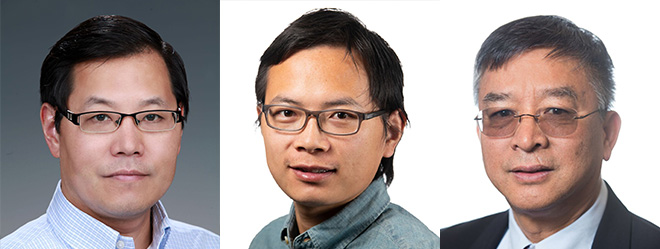 EN09.04.02 | Wednesday, April 12 at 9:00 a.m. PDTPNNL Authors: Wu Xu (presenter), Chao Zeng, Ji-Guang (Jason) Zhang Summary: Rechargeable lithium (Li) metal batteries with conventional intercalation cathodes are potential next-generation energy storage systems for transportation and smart grid applications. We found that the microstructure of the battery separator has a significant influence over the Li deposition behavior, and consequently, the cycling performance of Li metal batteries. READ MORE. |
Controlled Assembly of Sequence-Defined Peptoids into Hierarchical Materials SB06.04.04 | Wednesday, April 12 at 9:15 a.m. PDTPNNL Author: Chun-Long Chen (presenter) Summary: Peptoids have received increasing attention for the design and synthesis of functional materials with hierarchical structures. We recently designed short peptoid oligomers for controlled assembly into twisted nanoribbons, helices, along with nanosheets and nanotubes. Tuning can significantly influence the peptoid assembly pathways and dynamics for the formation of hierarchical materials with designed morphologies. READ MORE. |
Facet-Dependent Dispersion and Aggregation Behavior of Aqueous Hematite NanoparticlesSF05.05.06 | Wednesday, April 12 at 9:30 a.m. PDT PNNL Authors: Kevin Rosso (presenter), Duo Song, Sebastian Mergelsberg, Narendra Adhikari, Nabajit Lahiri, Yatong Zhao, Ping Chen, Zheming Wang, Xin Zhang Summary: The aggregation state of nanoparticles in solution plays a commanding role in their function. We systematically studied the dispersion/aggregation behavior of three sets of hematite nanoparticles. Our findings validate the notion that nanoparticle dispersion can be controlled by expressing specific facets for specific solvents and may help in the development of various nanoparticle applications. READ MORE. |
Defect Pathways for the Disordering of Oxide Electronics in High-Radiation EnvironmentsSF02.04.06 | Wednesday, April 12 at 10:45 a.m. PDT PNNL Authors: Bethany Matthews (presenter), Kayla Yano, Sarah Akers, Michel Sassi, Sandra Taylor, Le Wang, Yingge Du, Steven Spurgeon Summary: It is important to understand how materials degrade under irradiation. Oxide thin films make up crucial portions of many electronic components, therefore we chose to examine thin films of LaFeO3 grown on SrTiO3 (001) substrates. Our findings suggest that defective regions of these films break apart first under irradiation. Additionally, we found that while material composition can have a strong effect, compositional microstructural uniformity is more important for material robustness under ion irradiation. READ MORE. |
Cryo-TEM for Rechargeable Battery – Does Cooling Solve the Beam Sensitive Problem We Face?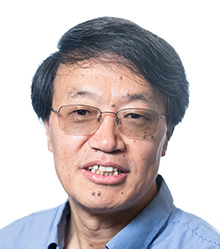 CH02.02.01 | Wednesday, April 12 at 1:30 p.m. PDTPNNL Author: Chongmin Wang (presenter) Summary: Imaging can inadvertently affect the object being observed. Modification of battery materials by the electron beam during imaging has been widely noted, making the capture of useful information challenging. We discuss the latest advances in cryo-TEM and its application for probing the structural and chemical evolution of rechargeable batteries. READ MORE. |
Effect of Contacts in Assemblies on Nanoparticals on Hydrogen Adsorption EN07.05.03 | Wednesday, April 12 at 2:15 p.m. PDTPNNL Authors: Nanjun Chen (presenter), Hyoju Park, Micah Prange, Dongsheng Li, Peter Sushko Summary: We investigated strain distribution in assemblies formed by the attachment of metastable Pt and Pd nanoparticles. Through the formation of coherent and incoherent interfaces at the particle-particle contacts, these systems give rise to unusual coordination environments and strain that may affect their catalytic activity. This study deepened our mechanistic understanding of the role of nanoparticle contacts in hydrogen adsorption and suggested a viable path toward achieving the rational design of hierarchical structures that have a high affinity to hydrogen. READ MORE. |
Understanding Competitive Electrochemical Reactions on Strained Surfaces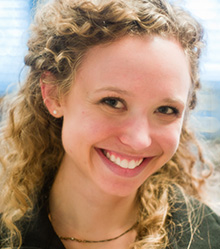 EN07.05.05 | Wednesday, April 12 at 3:15 p.m. PDTPNNL Author: Kelsey Stoerzinger, Joint Appointee (presenter) Summary: The complex interface formed in heterogeneous electrocatalysis can change dramatically with the electrochemical potential that drives such reactions. We have been investigating how metal electrocatalysts react with species from aqueous solution by combining electrochemical approaches with complementary spectroscopy. We will share how changes in a material’s bulk influence competitive processes on the surface and the formation of hydride phases under electrochemical conditions. READ MORE. |
Design Novel Polymer Materials for Advanced Redox Flow Battery TechnologyCH01.08.14 | Wednesday, April 12 at 5:00 p.m. PDT PNNL Authors: Hyung-Seok Lim (presenter), Sujong Chae, Litao Yan, Guosheng Li, Ruozhu Feng, Yongsoon Shin, Zimin Nie, Bhuvana Sivakumar, Xin Zhang, Yangang Liang, David Bazak, Shuttha Shutthanandan, Vijay Murugesan, Soowhan Kim, Wei Wang Summary: We have demonstrated a new gel polymer interface (GPI) for vanadium-based redox flow batteries. Results proved that the GPI is effective in maintaining the concentration of vanadium species in their respective half-cells, resulting in improved cycling stability because it prevents active species from crossing the membrane and stabilizes the oxidation states of active species. The cross-linked GPI is chemically stable for 100 cycles without the dissolution of polymers and/or swelling. READ MORE. |
Effects of Crystal Lattice Deformation on Catalytic Activities EN07.07.06 | Thursday, April 13 at 10:30 a.m. PDTPNNL Authors: Dongsheng Li (presenter), Miao Song, Zexi Lu, Hyoju Park, Micah Prange, Peter Sushko Summary: Deformations of hierarchical structures at the atomic scale, especially long-range ones, can significantly enhance their behavior. We designed the deformations in the crystal lattice to enhance the catalytic functionality of catalysts by controlling phase transformation and particle aggregation. We discovered a physical picture of transitional structures, in which continuous variations in atomic positions form along these two phase-transformation pathways. These findings suggest that extended gradient structures can be designed to advance new functions. READ MORE. |
Probing Aluminum-Oxo 2D Cluster Assembly Pathways to Gibbsite Nanoplates NM04.07.01 | Thursday, April 13 at 1:30 p.m. PDTPNNL Authors: Xin Zhang (presenter), Ying Chen, Sebastian Mergelsberg, James De Yoreo, Carolyn Pearce, Kevin Rosso Summary: Aluminum is the third-most abundant element in Earth’s crust and aluminum hydroxide polymorphs dominate aluminum ores. Understanding the crystallization pathways of aluminum hydroxide polymorphs is important to geochemistry, environmental science, energy storage, catalysis, biomedicine, industrial processing, and even nuclear waste treatment. Here we probe the nucleation and crystal growth mechanisms of gibbsite nanoplates in detail. These findings are important for developing new methods for morphology and size-controlled synthesis of 2D aluminum hydroxide materials. READ MORE. |
Improve the Kinetics of the Ketone-Based Aqueous Organic Redox Flow BatteriesEN09.07.04 | Thursday, April 13 at 3:30 p.m. PDT PNNL Authors: Ruozhu Feng (presenter), Ying Chen, Xin Zhang, Peiyuan Gao, Ping Chen, Sebastian Mergelsberg, Lirong Zhong, Aaron Hollas, Yangang Liang, Vijayakumar Murugesan, Qian Huang, Yuyan Shao, Wei Wang Summary: Redox flow batteries may enable cost-effective long-duration energy storage to address renewable-driven intermittency in the electric power sector. We show how strategic design principles can accelerate alcohol oxidation and enhance battery kinetics. Fluorenone-based flow battery electrolytes demonstrate enhanced rate capability, high battery capacity, and record-breaking long cycling. This study opens a new avenue to improving the kinetics of aqueous organic flow batteries. READ MORE. |
For more information about physical and computational sciences at PNNLClick on the flyers below to learn about our physical and computational sciences, including our mission, goals, achievements, and features of the new Energy Sciences Center. | |||
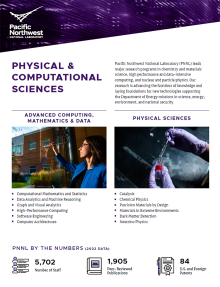 |  | ||
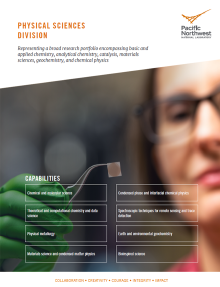 |  | ||